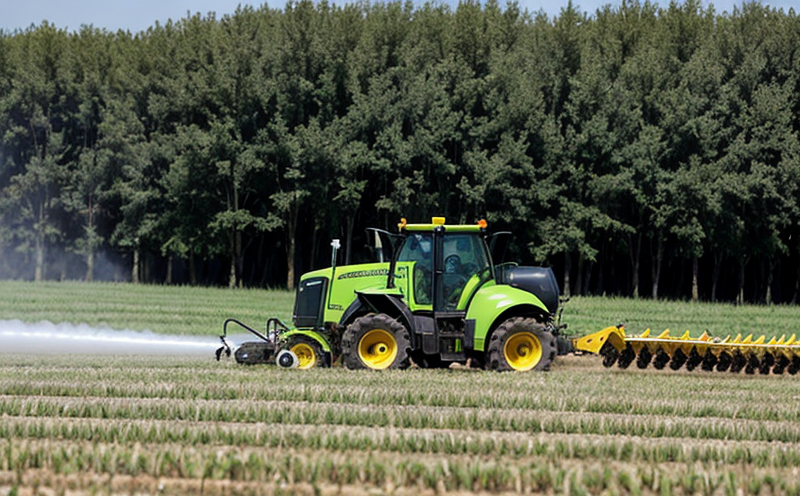Zineb Residue Testing in Crops
When it comes to Zineb residue testing in crops, understanding the levels of this fungicide can be crucial for both food safety and environmental sustainability. Zineb is a widely used fungicide that helps protect crops from fungal diseases; however, its presence in agricultural products must be controlled to prevent adverse health effects on consumers. This service focuses on providing accurate, reliable testing to ensure compliance with regulatory standards and consumer safety.
Our laboratory specializes in the analysis of Zineb residues using advanced chromatographic techniques such as Liquid Chromatography-Mass Spectrometry (LC-MS) which offers high sensitivity and selectivity for detecting even trace amounts of Zineb. The service is designed to cater not only to quality managers but also compliance officers, R&D engineers, and procurement personnel who need precise data on the levels of Zineb in their products.
The importance of this testing cannot be overstated as improper application can lead to residues that exceed safe limits set by regulatory bodies like the World Health Organization (WHO) and the European Food Safety Authority (EFSA). These organizations recommend maximum residue limits (MRLs) for various crops to ensure public health is protected. Our laboratory adheres strictly to these guidelines, ensuring that our clients receive accurate results that are compliant with international standards such as ISO 17025.
A key aspect of this service is the preparation of samples before analysis. Depending on the crop type and expected residue levels, different methods may be employed. For instance, leafy vegetables might require extraction using a mixture of solvents like acetonitrile or methanol followed by cleanup steps to remove interfering components. Once prepared, these extracts undergo instrumental analysis which provides quantitative data about Zineb residues.
The results from this testing are essential for several reasons. Firstly, they allow farmers and agricultural businesses to adjust their practices if necessary to stay within legal limits. Secondly, it gives peace of mind to those involved in food production that their products meet the highest quality standards required by international markets. Lastly, compliance with these tests can also help avoid potential legal issues arising from non-compliance.
To summarize, Zineb residue testing plays a vital role in ensuring both consumer safety and regulatory adherence within agricultural practices. By offering this specialized service, we aim to support our clients in maintaining the highest standards of food quality and safety.
Why It Matters
The significance of Zineb residue testing extends beyond just meeting legal requirements; it has profound implications for public health, environmental protection, and agricultural efficiency. Excessive levels of Zineb in crops can pose serious risks to human health through ingestion or contact with contaminated produce. Fungicides like Zineb are designed to control fungal growth but their use must be carefully managed to avoid unintended consequences.
- Health Risks: Overexposure to Zineb has been linked to several health issues including skin irritation, respiratory problems, and potential carcinogenic effects. Therefore, monitoring residue levels is crucial for maintaining safe consumption practices.
- Environmental Impact: Improper disposal or runoff from treated fields can contaminate soil, water sources, and nearby ecosystems leading to broader ecological damage far beyond the immediate farm area.
- Agricultural Efficiency: Accurate residue testing helps optimize application rates thereby enhancing crop yield without compromising product quality. This efficiency translates directly into improved profitability for farmers while reducing waste and resource usage.
In essence, Zineb residue testing is not merely a compliance exercise but an integral part of sustainable agricultural practices aimed at safeguarding both human health and the environment.
Scope and Methodology
| Sample Preparation Steps | Instrumental Analysis | Data Interpretation Criteria |
|---|---|---|
|
Utilize Liquid Chromatography-Mass Spectrometry (LC-MS) technology, which provides high sensitivity and selectivity necessary for detecting trace amounts of Zineb. |
Data interpretation follows internationally recognized standards such as ISO 17025. Results are compared against set MRLs to determine compliance with regulatory requirements. |
Our laboratory ensures that every step in the process adheres strictly to established protocols and best practices, ensuring accurate and reliable results.
Customer Impact and Satisfaction
- Precision: By providing precise measurements of Zineb residues, our tests enable clients to make informed decisions regarding their farming practices.
- Compliance Assurance: Ensuring that all results comply with international standards helps avoid penalties associated with non-compliance.
- Quality Control: Regular testing allows for continuous monitoring of product quality, helping maintain a consistent standard across batches and over time.
- Market Access: Meeting stringent residue limits opens up opportunities for exporting to countries with strict import regulations.
- Customer Trust: Reliable test results build trust among consumers who value safe and high-quality produce.
- Economic Benefits: Avoiding overuse of fungicides not only reduces costs but also enhances market competitiveness.
These benefits contribute significantly to customer satisfaction, making our services indispensable for maintaining a robust supply chain in the agricultural sector.





